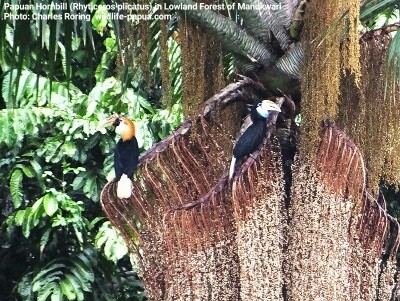Blyth's Hornbill (Rhyticeros plicatus) is a species of bird that lives in tropical rainforest of New Guinea (PNG and West Papua) and its surrounding islands. The indigenous people in Papua Barat region see the bird as Symbol of True Love. A couple of hornbill is usually seen sitting in trees or flying in the air. They find fruiting tree, or sit on the branch of a tree together. After mating, female Blyth's hornbill will get pregnant and later will lay her egg(s) in a hollow of a tree trunk. She will take care of her baby until it is big enough to live by his or herself. During that time, male Blyth's hornbill fly to all corners of the forest to feed the mother and her baby. Fruits that Blyth's hornbill like to eat include nutmeg and ficus.
Local villagers in West Papua say that if one of the couple dies, the one that survives will live alone until the end of his or her life. Blyth's hornbill often fly in a group of 2, 4, or even more. Personally I used to see a huge group of hornbill, more than 30 of them, flying in the air. They usually fly to certain area of the forest to find fruits.

Blyth's Hornbill is the only hornbill species in New Guinea and its surrounding islands. There are 57 species of hornbills in the world that are known to science.
In West Papua, Blyth's Hornbill is called burung taun-taun. This bird is considered as a very important seed disperser for the ecosystem of tropical rainforest. It eats fruits and releases its seeds every where in the forest. Blyth's hornbill, together with other birds and animals that spread seeds, play vital roles in growing or expanding tropical forest. Although its population is still high, in recent years, its habitat is shrinking rapidly. Tropical rainforest in lowland and hills are being cut and converted into monoculture palm oil plantation, human settlements, roads or mining concession. The rise in human population increases the needs for sawn wood. People have exploited wood from rainforest for along time.

When tropical rainforest is cut, its biodiversity is destroyed. So, it is not only the blyth's hornbill that is threatened but also the whole plants and animals that live in the forest.
Birdwatching as an ecotourism activity is one of the solutions that I offer to people in some villages in West Papua to help them preserve rainforest. Villagers will work as guides, porters, supplier of foods, cooks and providers of homestays. When local people can get economic benefits from birdwatching tourism, they will seriously protect their forest. Using the wealth of natural resources in the forest sustainably, villagers can improve their living condition, and alleviate poverty without having to destroy their forests.
Watching Sites
Blyth's Hornbill can be watched in almost all region of New Guinea. In West Papua, the recommended birding sites are listed below:
- Tambrauw Mountains - Ayapokiar Village, Sayam firest in Miyah, Ases valley and Mount Sakofsiah as well as Fef town (capital of Tambrauw regency) are the most recommended birding sites in Tambrauw. In addition to hornbill, visitors will be able to watch various species of other birds including Magnificent Bird of Paradise, Lesser Birds of Paradise, New Guinea Harpy Eagle, Variable Goshawk, Pink-spotted Fruit Dove, Wompoo Fruit Dove, Red-flanked Lorikeet, Josephine's Lorikeet, New Guinea Vulturine Parrot, Black-browed Triller, and etc. There is a birding guide in Fef town. His name is Nico Nauw. He can be contacted by whatsapp or text message through this number: +62 821 9806 0084.
- Wondama Regency - There are also a lot of places which visitors can go to watch Blyth's Hornbill and other tropical birds of New Guinea including Palm Cockatoo, Sulphur-crested Cockatoo, Eclectus Parrot, White-bellied Sea Eagle, Willie Wagtail, Lowland Peltop, and etc.
- Manokwari has been famous for years as an important destination for birdwatching. Arfak mountains, especially in its higher elevation forest, have got such endemic birds as Vogelkop Bowerbird, Western Parotia, Long-tailed Paradigalla, Vogelkop Melidectes, and etc. For watching Blyth's Hornbill, the Mesirrokow forest, is a highly recommended birding site.
- Sorong Regency is the main gate for visitors who plan to travel to Raja Ampat islands. It has got a lot of birding sites too. The most important destination is Klasow valley. There are tens of villages in the valley. Klatomok village which is a road side village is a nice base for birding visitors. There are homestays in the village for birdwatchers to stay. Birds such as Shining Flycatcher, Black-sided Robin, Common Paradise Kingfisher, Red-breasted Paradise Kingfisher, Yellow-faced Myna, Dollarbird, Lowland Peltop, Hooded Butcherbird, Blue-black Kingfisher can be watched in the forest.
- Raja Ampat Islands - Waigeo is a highly recommended island for birdwatching. Forest at Warduwer Beach where Raflow resort is located is a good base for birdwatchers. Here birds such as Beach Kingfisher, Palm Cockatoo, Rufous-bellied Kookaburra, Pinon Imperial Pigeon, Beautiful Fruit Dove, Mimic Meliphaga, Torresian Crow, Sacred Kingfisher, Tern, Willie Wagtail, Eastern Osprey, Brahminy Kite, Dusky Scrubfowl, Red Bird of Paradise, and etc. can easily be watched. Blyth's Hornbill is a daily occurance at this beach.
If you are interested in traveling to West Papua to enjoy birding, and wildlife watching as well as swimming and snorkeling and want me to organize your trip. Please, contact me (Charles Roring) by email to: peace4wp@gmail.com or by whatsapp to: +62 813 3224 5180.